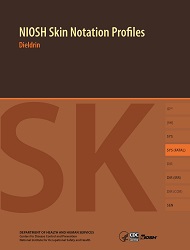NIOSH Skin Notation Profiles: Dieldrin
July 2015
DHHS (NIOSH) Publication Number 2015-194

As the largest organ of the body, the skin performs multiple critical functions, such as serving as the primary barrier to the external environment. For this reason, the skin is often exposed to potentially hazardous agents, including chemicals, which may contribute to the onset of a spectrum of adverse health effects ranging from localized damage (e.g., irritant contact dermatitis and corrosion) to induction of immune-mediated responses (e.g., allergic contact dermatitis and pulmonary responses), or systemic toxicity (e.g., neurotoxicity and hepatoxicity). Understanding the hazards related to skin contact with chemicals is a critical component of modern occupational safety and health programs.
This Skin Notation Profile provides the SK assignments and supportive data for dieldrin. In particular, this document evaluates and summarizes the literature describing the hazard potential of the substance and its assessment according to the scientific rationale and framework outlined in CIB 61. In meeting this objective, this Skin Notation Profile intends to inform the audience—mostly occupational health practitioners, researchers, policy- and decision-makers, employers, and workers in potentially hazardous workplaces—so that improved risk-management practices may be developed to better protect workers from the risks of skin contact with the chemicals of interest.
